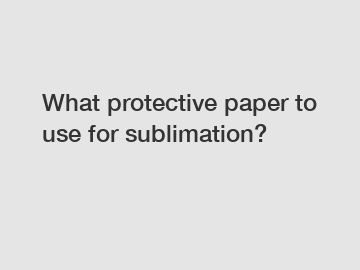What protective paper to use for sublimation?
What protective paper to use for sublimation?
Sublimation printing has gained popularity in recent years due to its ability to produce vibrant and durable prints on various materials. From customized apparel to personalized home décor, sublimation printing allows for endless possibilities. However, to ensure the best results, it is crucial to use the right protective paper during the sublimation process. In this article, we will explore different options and discuss their advantages and disadvantages.
1. Teflon Sheets:

Teflon sheets are widely used in sublimation printing as they offer excellent heat resistance and non-stick properties. These sheets are smooth, versatile, and can withstand high temperatures without melting or releasing harmful fumes. Teflon sheets ensure that the sublimation ink transfers solely onto the intended substrate, preventing any bleed-through or ghosting. Moreover, they are reusable and easy to clean, making them a cost-effective choice for sublimation printing.
2. Silicone Sheets:
Silicone sheets are another popular option for sublimation printing. They are durable, heat-resistant, and facilitate even heat distribution, ensuring a consistent transfer of ink. Silicone sheets provide a smooth surface for the transfer process and are effective in preventing color contamination between different projects. However, unlike Teflon sheets, silicone sheets are not non-stick, which may result in slightly increased drying times and some minor sticking.
3. Parchment Paper:
A readily available and cost-effective option, parchment paper is commonly used for sublimation printing. It acts as a protective barrier between the sublimation transfer paper and the heat press, preventing any ink from transferring onto the press or causing any damage. Although parchment paper does a decent job in protecting the heat press, it is not as reliable as Teflon or silicone sheets in terms of preventing ink bleed-through. As a result, parchment paper may be more suitable for basic sublimation projects with limited color areas.
4. Butcher Paper:
Often used in cooking, butcher paper can also be utilized as a protective paper during sublimation printing. It is a low-cost option compared to Teflon or silicone sheets, making it an attractive choice for beginners or those with budget constraints. However, it is important to note that butcher paper is not designed specifically for sublimation printing, so its heat resistance may be lower than other options. This may result in reduced image clarity and potential ink smearing.
In conclusion, choosing the right protective paper is essential for achieving excellent results in sublimation printing. Teflon sheets provide exceptional heat resistance and non-stick properties, ensuring precise and clean transfers. Silicone sheets offer durability and even heat distribution, although they may require additional drying time and may stick slightly. Parchment paper is a cost-effective option but is less effective against ink bleed-through. Butcher paper is a budget-friendly choice but may not offer the same level of heat resistance and image clarity. Consider your specific needs and budget when selecting protective paper for your sublimation printing projects to achieve the best possible outcomes. So, what protective paper will you use for your next sublimation venture?
For more information, please visit sublimation on sticker paper, adhesive sublimation paper, customized fast dry sublimation paper.
63
0
0


Comments
All Comments (0)